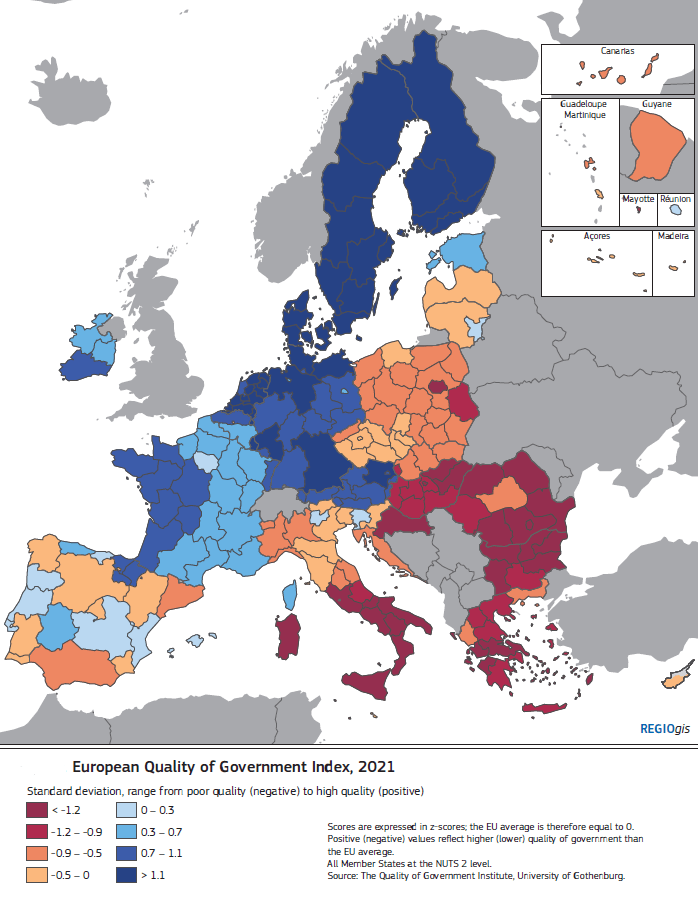Absorption capacity refers to EU member states’ ability to efficiently and effectively spend the financial resources which have been allocated to them. Member states absorb funding when they receive a payment from the EU budget as co-financing towards eligible projects in their respective countries. Cohesion policy funding is significant and should bring important benefits to EU citizens.
There are basically three main modalities of cohesion funds’ absorption capacity in the EU member states:
- macro-economic absorption capacity relates to the overall ability of the economy to generate viable investment opportunities that could be financed by external investment support.
- financial absorption capacity can be defined as the ability to co-finance EU supported programmes and projects, to meet additional requirements, to plan and guarantee any national contributions in multi-annual budgets and to collect these contributions from several partners interested in a program or project.
- administrative or institutional absorption capacity. On the demand side, administrative capacity is determined by the ability of project applicants to generate projects that meet the bidding requirements of the public ordering procedure used. On the supply side, administrative capacity is determined by the ability of the authorities to manage cohesion policy funds entrusted to them effectively and efficiently in all stages of the programming process – from initial planning to implementation and evaluation of projects.
Absorption of the EU cohesion funds in practical terms: focus exclusively on spending the allocated funds
In simplified terms, the absorption of the EU funds is most often understood as the ability of a given country, region or programme to spend funds received from the EU. The indicator of success in this area is the percentage EU funds used in relation to the allocation at the end of the reporting period and/or at the end of the financial perspective.
Such an approach to the degree of absorption most often dominates both in scientific research and reports prepared by the member states and the EU institutions such as the European Commission or the European Court of Auditors. This is due to the fact that it is relatively easy to measure and in a synthetic way shows the ability of the entire institutional system (treated broadly: institutions, the use of procedures and interactions with stakeholders) but also the ability to mobilise the political level in order to spend the available EU funds.
In many countries of Central and Southern Europe, this kind of absorption capacity understanding has been subject of public and media interest as well as lively political discourse. The focus point in such debates is always on not “losing” any penny from the allocated funds. Therefore, the achieved percentage of spending in relation to allocation has become a very important indicator of absorption capacity and thus – as a proxy – a reflection of the quality of the cohesion policy management system in individual countries.
The amount of funds that must be spent at the end of the Multiyear funding framework (MFF) in order not to lose the allocated sums are the highest in recent years. This impacts a large number of big infrastructure projects, whose implementation periods are the longest in recent years: e.g. in Poland, at the end of January 2023 it was still 30% of value of all allocated funds to be spend and proved to the European Commission before the end of 2023 (the end of the implementation period for 2014-2020).
Concentration of attention by the member states on spending as much of the financial resources as possible, regardless of their effectiveness in achieving the assumed objectives and results (promoting structural changes, building competitiveness and socio-economic cohesion) has been criticised for years – both by the scientific community, the EU institutions and periodically by the member states themselves.
From the perspective of the last twelve years, it can be concluded that the criticism of focusing the attention of EU cohesion policy on how to safeguard against the loss of EU funds at any cost has led to a relative loss of importance of the percentage of funds used in relation to the allocation of funds as the most important indicator for the absorption of EU funds.
Absorption of the EU cohesion funds in practical terms: stage two – value-for-money of spending becomes more important
Under the EU cohesion policy in the MFF 2014-2020 and the new one for years 2021-2027 an important aspect of assessing the absorption of individual member states and regions is also the assessment of the ability to achieve the set development goals. In practical terms, this means for the MFF 2021-2027 that programmes and funds (measured at the level of specific objectives) that will not achieve the assumed milestones and targets set for output and result indicators within the so-called performance framework (Article 16 of the Common Provisions Regulation 2021-2027) could experience suspension of payments or even their loss.
In order to increase efficiency of spending EU funds the so-called ex-ante conditionalities were introduced into the MFF 2014-2020. The ex-ante conditionality requires a Member State to achieve a pre-defined key condition (of institutional or legal nature) before starting the implementation of a relevant priority of the European structural and investment fund (ESIF) programme.
Within the MFF 2021-2027, there is also a strengthened mechanism for linking the European Structural and Investment Funds to the European economic governance (European Semester). Funds may be withheld or even lost by the EU member states due to the lack of full implementation of country specific recommendations, which are issued annually by the Council within the European Semester cycle. The recommendations for each individual member state aim at improving the quality of implementation of various national public policies (not only those directly related to the implementation of cohesion policy) and their compliance with existing EU priorities (e.g. in terms of macroeconomic stability, labour policy or the implementation of the European Green Deal).
Quality of governance and absorption capacity
Quality of government is a broader concept than administrative capacity for implementation of structural funds. The most important quality of government components include: (i) effective regulatory framework for implementing public policies. (ii) human and social capital, (iii) effective administration in delivery of public goods and services, (iv) effective system of multilevel governance and partnership, and (v) political context including the level of commitment to Europeanisation process.
Below, you can see the 2021 European quality governance index. As can be seen, the quality of government index is generally higher in the countries and regions that are more developed, i.e., having higher levels of GDP per capita or Human Development Index (HDI). This, however, does not mean that all poorer countries and regions are slow in implementation of structural funds and/or that their effectiveness in achieving goals of the policy is lower than in more developed states and regions.
European Quality of Governance Index, 2021
Source: European Commission. 8th Cohesion Report, 2022.
The administration capacity of a country is correlated with the level of the quality of government but only to a limited extent. It seems, for example, that countries with higher allocation of structural funds in comparison to their GDP or public spending tend to perform better than those in which cohesion policy transfers represent a smaller portion of the GDP and overall public spending. This is probably the result of the higher political commitment in the former group of countries fuelled by higher reliance on the EU transfers as the main source of investment.
It is interesting that there is no clear link between the level of regionalisation and administrative capacity to absorb the EU funds. There are examples of well performing countries with regard to absorption of EU funds having high (such as Poland) and no-existing (Baltic States) or low level of regional autonomy. It seems that from a technical point of view the most important factor for the speed and level of absorbing funds is a well-functioning institutional system of implementation in which the government and appointed territorial authorities have been assigned clear responsibilities and are able to cooperate smoothly at any territorial level.
Importantly, some studies suggest that decentralisation, especially in the case of bigger states in well developed countries, is an important factor in speeding up processes of modernisation, structural transformation and making positive use of integration processes such as globalisation and Europeanisation.
Key determinants of the EU cohesion funds’ absorption capacity
As discussed above, the European Structural and Investment Funds absorption capacity in a narrower sense is defined as the overall ability of the public administration of a state or region. In broader sense, these are all institutions involved in the process of programming, management monitoring and financing projects to implement programmes and projects co-financed by structural and cohesion funds according to requirements of EU legislation.
One should pay attention to the role of institutions and governance with regard to development. Usually, a higher quality of government is associated with a better regional innovative performance. Moreover, the better the institutional quality and the higher the investment in local roads, the higher is an increase in regional GDP in response to the program.
One can identify four thematic groups of key factors (based on the programming cycle) influencing the ability to implement the EU structural funds and effectively use it for the process of modernisation and achievement of European goals and values, namely:
- Programming – factors influencing the ability of the member state to programme the EU expenditures at strategic and operational levels;
- Management – factors influencing ability to manage effectively the process of coordination and implementation of the EU structural funds at strategic and operational levels;
- Monitoring and Control – factors influencing the process of monitoring and control of programmes and projects;
- Evaluation and learning factors influencing the ability to learn from problems and mistakes and follow good examples.
For the purpose of this article, we overview just three important aspects: (1) effective coordination system, (2) high-quality administration and (3) effective and simple legislative system.
Effective coordination system
The coordination challenge is higher in bigger countries with higher shares of EU structural funds in relation to their GDP and hence requiring more complicated implementation structures and more stakeholders to cooperate with. Proper coordination is ensured by individual Member States through appropriate legislation, creation of specific institutions to deal with relevant management issues (e.g. coordination bodies, monitoring committees) and appropriate procedures. Due to the increasing pressure of the European Commission on the use of territorial instruments addressed to functional areas (metropolitan, sub-regional, rural, specific areas like dependent on fossils and others), organisations and structures representatives of these areas must also be included in this system.
High quality of administration and stability of employment
The absorption capacity of the EU funds is very much related to the quality of public administration. In many Central European countries, special institutions or units within existing structures have been set up for the implementation of cohesion policy programmes. They are still characterised by a greater understanding of European rules and the ability to apply them in national conditions.
The EU Member States which joined after 2004 coped much better with the implementation of the EU funds than it would result from their general level of quality of government. However, among this group we can find examples of countries that initially had considerable difficulties in absorbing the EU funds due to the lack of functioning of their civil service and the low stability of their institutional system. The costs of having an efficient administration capable of absorbing the EU funds are considerable and can reach up to 3-4 percent of the value of all transfers.
Effective and simple legislative system
The implementation of the EU Structural Funds is based on the EU regulations which are directly applicable in the EU Member States. To clarify certain provisions of the regulations, the European Commission prepares implementing acts and guidelines, which formally have no legal force. They however play an important role in clarifying and guiding the methods for applying the principles of cohesion policy and for specifying individual provisions of regulations.
This means that, in theory, there is no need to adopt national legislation for the implementation of the EU cohesion policy. However, in practice EU Member States tend to adopt legal acts or national guidelines for different groups of beneficiaries and related to different processes (eligibility of funding, rules for territorial instruments, monitoring, evaluation, promotional activities and others).
However, to be able to implement projects co-financed by the EU ESIFs, it is necessary to harmonise the national law with EU law in some specific areas: environmental regulations, regulations related to public procurement, competition policy or in the field of non-discrimination and equal opportunities policy are of fundamental importance here. It is therefore necessary to build a system for monitoring the compliance of National legal regulations and taking proper legislative initiative, if necessary, on the part of the Member States to ensure good absorption of funds.
This short article has been produced with the assistance of the European Union and its member states Germany, Poland, Sweden, Denmark, Estonia and Slovenia. It is part of a Policy Paper “Ukraine’s EU Accession Process in the field of Regional and Local Development, Ministry responsible for regional and local development in the driving seat!”, jointly prepared by prof. Mojmir Mrak and prof. Piotr Zuber, international experts of U-LEAD with Europe, in March 2023 (U-LEAD with Europe – Ukraine’s EU accession process in the field of regional and local developm…). All terms in this article are meant to be used neutrally for men and women.
Attention
The authors do not work for, consult to, own shares in or receive funding from any company or organization that would benefit from this article, and have no relevant affiliations






